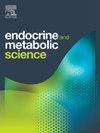Impact of remdesivir on liver function: A comparative study of diabetic and non-diabetic COVID-19 patients
Q3 Medicine
引用次数: 0
Abstract
This study aimed to evaluate the effect of remdesivir on liver tests in diabetic and non-diabetic COVID-19 patients through a multicenter study conducted in Southeast Iran. Therefore, 200 participants, comprising 98 patients with diabetes and 102 non-diabetic subjects, were assessed based on the Declaration of Helsinki, with proper inclusion, and exclusion criteria. Demographic data were collected using a detailed questionnaire and a clinical checklist documenting underlying health conditions, particularly diabetes and hypertension. Liver function tests measured key enzymes and substances, including aspartate aminotransferase (AST), alanine aminotransferase (ALT), alkaline phosphatase (ALP), and total bilirubin, and data analysis was performed using SPSS (Confidence Interval = 0.95, p ≤ 0.05). Key findings indicate a significant correlation between increasing age and diabetes prevalence, with older age groups exhibiting higher rates of diabetes. Gender analysis revealed a slight predominance of females among diabetic patients, while educational attainment appeared lower in this group, suggesting a potential link between education and diabetes incidence. In patients with diabetes, AST levels rose from 19.2 ± 2.1 U/L before treatment to 25.3 ± 3.1 U/L after treatment, while ALT levels increased from 18.1 ± 1.4 U/L to 23.5 ± 2.2 U/L. Non-diabetic patients showed less pronounced increases in liver enzymes, with AST rising from 28.7 ± 3.1 U/L to 13.2 ± 2.1 U/L after treatment and ALT changing from 18.6 ± 3.2 U/L to 19.6 ± 3.1 U/L. Health-related factors, particularly the prevalence of hypertension and obesity, were notably higher among patients with diabetes. Lifestyle behaviors, including smoking and physical activity levels, further distinguished the two groups, with patients with diabetes showing a higher smoking prevalence and a lower engagement in regular exercise. The impact of remdesivir treatment on liver function revealed significant increases in liver enzyme levels among patients with diabetes post-treatment, contrasting with stable liver function in non-diabetic patients. The study underscores the intricate relationship between diabetes, liver health, and COVID-19, emphasizing the importance of considering comorbidities in treatment and management strategies for diabetic patients.
瑞德西韦对糖尿病与非糖尿病COVID-19患者肝功能影响的比较研究
本研究旨在通过在伊朗东南部开展的一项多中心研究,评估瑞德西韦对糖尿病和非糖尿病COVID-19患者肝脏检查的影响。因此,200名参与者,包括98名糖尿病患者和102名非糖尿病受试者,根据赫尔辛基宣言进行评估,并采用适当的纳入和排除标准。人口统计数据是通过详细的问卷调查和记录潜在健康状况的临床检查表收集的,特别是糖尿病和高血压。肝功能试验检测关键酶和物质,包括天冬氨酸转氨酶(AST)、丙氨酸转氨酶(ALT)、碱性磷酸酶(ALP)和总胆红素,数据采用SPSS统计软件进行分析(置信区间= 0.95,p≤0.05)。主要研究结果表明,年龄增长与糖尿病患病率之间存在显著相关性,年龄越大的人群糖尿病发病率越高。性别分析显示,糖尿病患者中女性略占优势,而这一群体的受教育程度较低,这表明教育程度与糖尿病发病率之间存在潜在联系。糖尿病患者AST水平由治疗前的19.2±2.1 U/L上升至治疗后的25.3±3.1 U/L, ALT水平由治疗前的18.1±1.4 U/L上升至23.5±2.2 U/L。非糖尿病患者肝酶升高不明显,治疗后AST由28.7±3.1 U/L上升至13.2±2.1 U/L, ALT由18.6±3.2 U/L上升至19.6±3.1 U/L。与健康相关的因素,特别是高血压和肥胖的患病率,在糖尿病患者中明显更高。生活方式行为,包括吸烟和体育活动水平,进一步区分了两组,糖尿病患者显示出更高的吸烟率和更低的定期锻炼。瑞德西韦治疗对肝功能的影响显示,治疗后糖尿病患者的肝酶水平显著升高,而非糖尿病患者的肝功能稳定。该研究强调了糖尿病、肝脏健康和COVID-19之间的复杂关系,强调了在糖尿病患者的治疗和管理策略中考虑合并症的重要性。
本文章由计算机程序翻译,如有差异,请以英文原文为准。
求助全文
约1分钟内获得全文
求助全文
来源期刊

Endocrine and Metabolic Science
Medicine-Endocrinology, Diabetes and Metabolism
CiteScore
2.80
自引率
0.00%
发文量
4
审稿时长
84 days
 求助内容:
求助内容: 应助结果提醒方式:
应助结果提醒方式:


